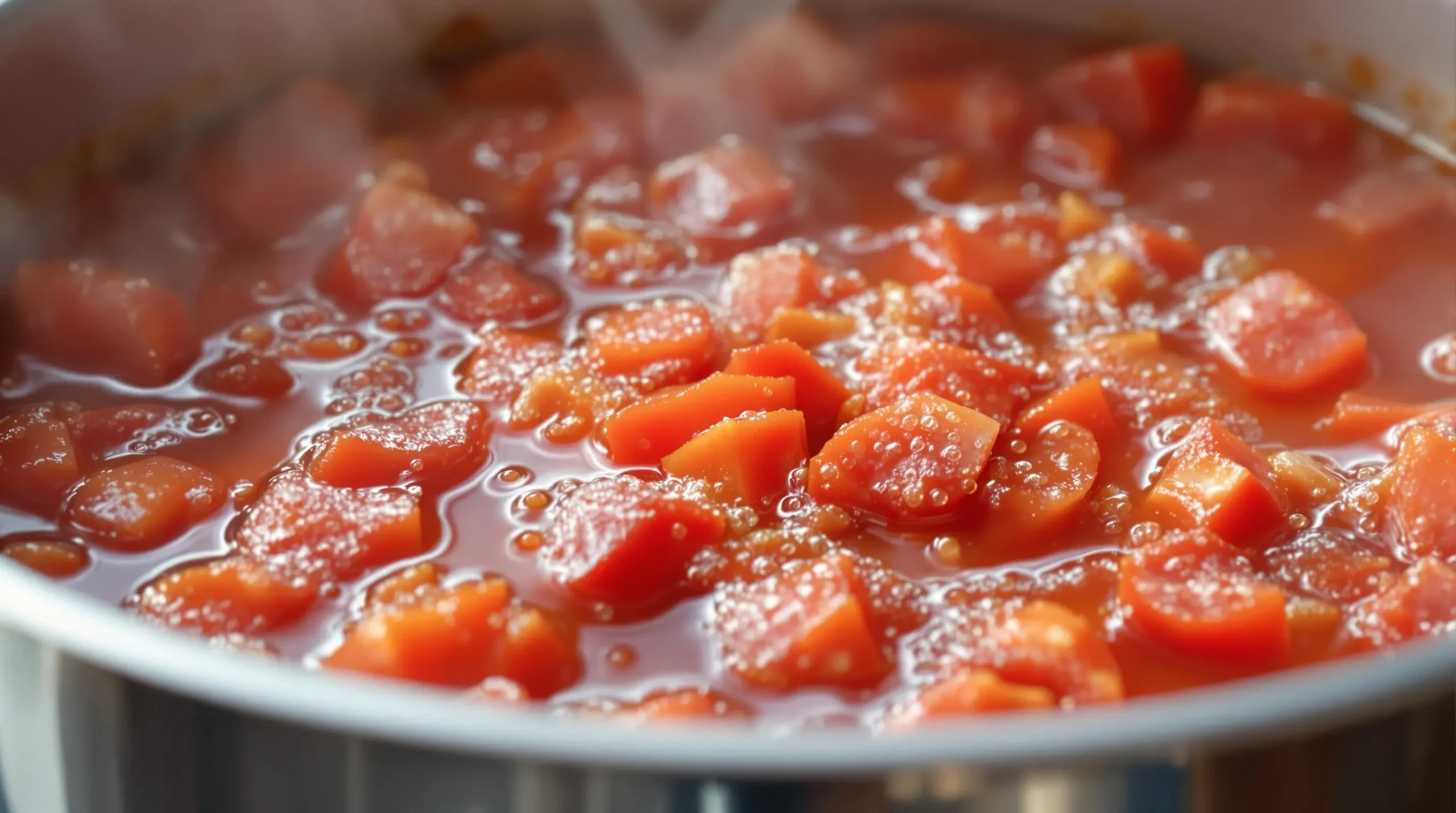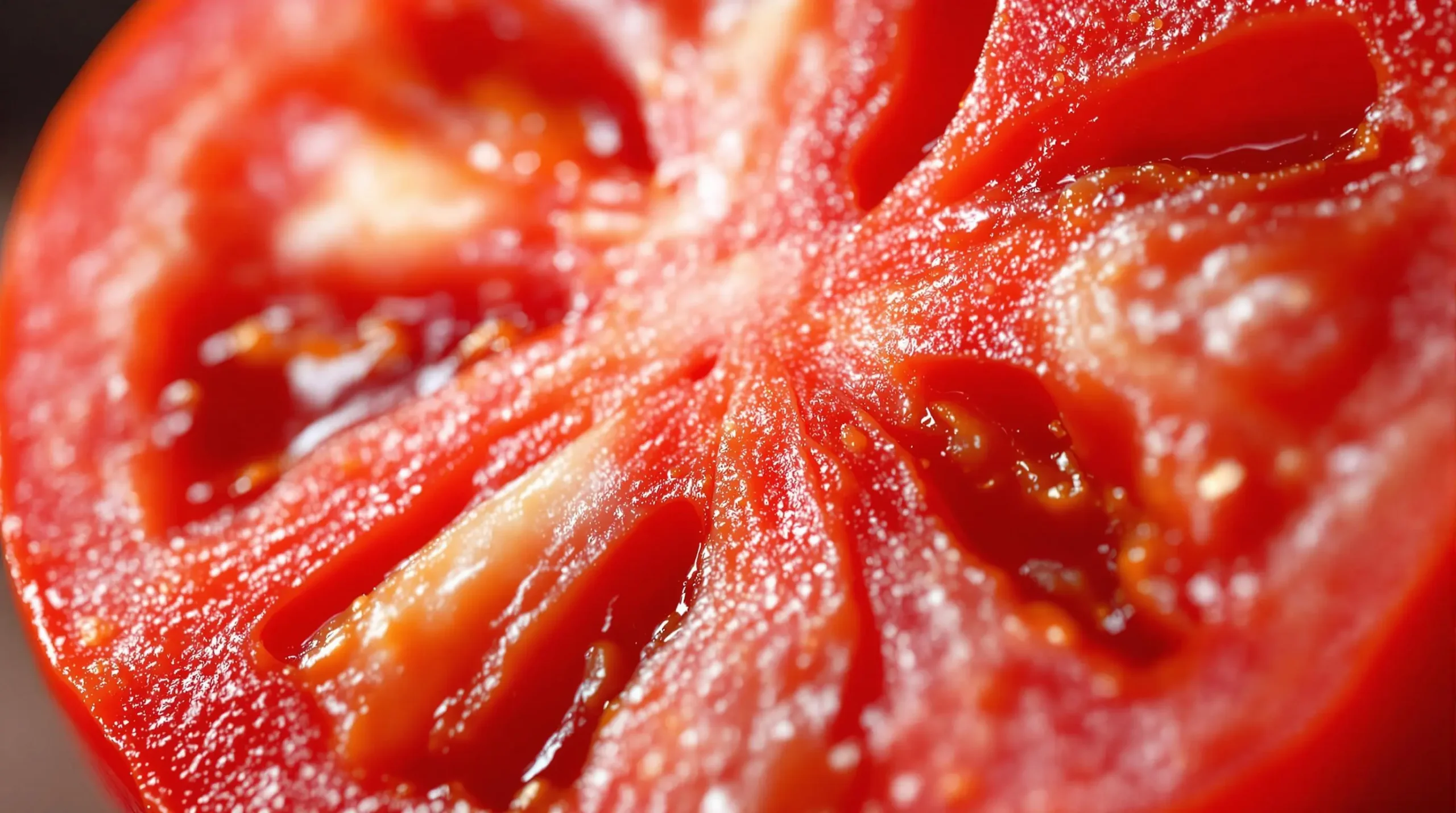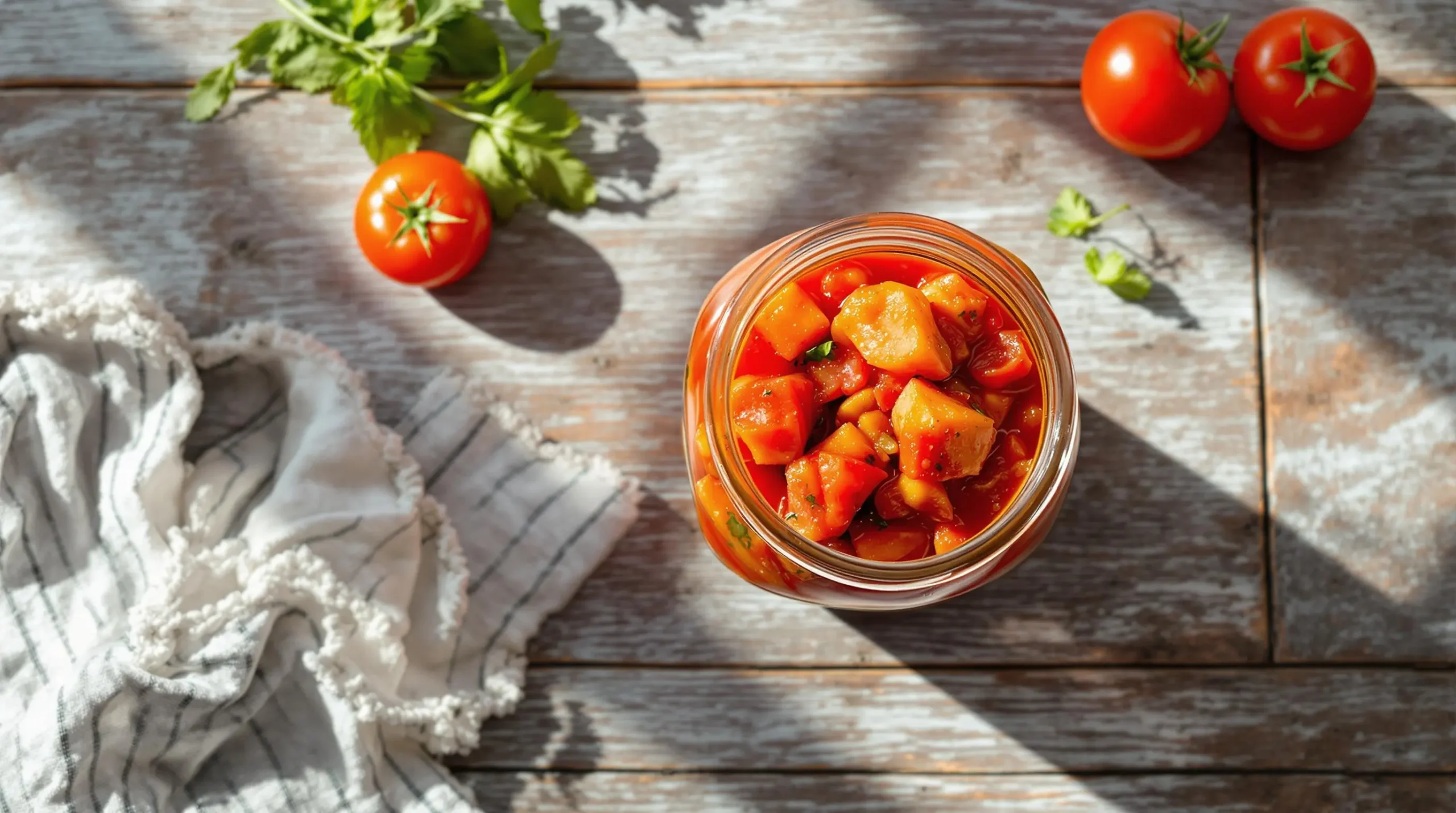There’s something magical about opening a jar of home-canned stewed tomatoes in the middle of winter and being transported back to the height of summer. As an avid gardener and food preserver, I’ve perfected my stewed tomatoes canning recipe over the years, and I’m excited to share these time-tested methods with you.
Whether you’re dealing with an abundance of garden tomatoes or want to take advantage of farmers’ market deals, learning how to can stewed tomatoes is a rewarding skill. Moreover, this stewed tomatoes canning recipe gives you complete control over the ingredients, allowing you to skip the preservatives and excess sodium found in store-bought versions.
The benefits of canning your own stewed tomatoes extend beyond just preserving the harvest. First, you’ll save money by buying tomatoes in season when prices are lowest. Additionally, having ready-to-use tomatoes in your pantry makes weeknight cooking much easier. Plus, there’s an undeniable satisfaction in knowing exactly what goes into each jar.
In this comprehensive guide, I’ll walk you through each step of the canning process, from selecting the right tomatoes to achieving a proper seal. You’ll learn about essential equipment like water bath canners, jar lifters, and other tools that make the job easier. Furthermore, I’ll share tips and tricks I’ve learned through years of experience to help ensure your success.
Let’s start by gathering the necessary supplies and preparing our workspace for a successful canning session.
Essential Equipment and Ingredients for Stewed Tomatoes Canning
Before diving into the stewed tomatoes canning recipe, let’s ensure you have everything needed for a smooth and safe canning session. Having the right equipment and ingredients ready makes the process much more enjoyable and successful.
Required Canning Supplies
A proper setup is crucial for safely preserving your stewed tomatoes. Here’s what you’ll need:
- Water bath canner with rack
- Clean canning jars (quart or pint size)
- New canning lids and rings
- Jar lifter
- Canning funnel
- Bubble remover tool
- Clean kitchen towels
- Timer
- Headspace measuring tool
Additionally, you’ll want basic kitchen items like large bowls, colanders, sharp knives, and measuring cups. I always recommend having extra jars and lids on hand, as you might need more than expected once you get started.
Selecting and Preparing Tomatoes
For the best results with this stewed tomatoes canning recipe, choose ripe, firm tomatoes without blemishes or soft spots. While any tomato variety works, I’ve found these perform exceptionally well:
- Roma or San Marzano
- Amish Paste
- Big Boy
- Better Boy
- Brandywine
Plan on about 3 pounds of tomatoes per quart jar. For a typical canning session, I usually prepare 20-25 pounds, which yields approximately 7 quarts. Moreover, selecting tomatoes at peak ripeness ensures the best flavor in your final product.
Additional Ingredients
Beyond tomatoes, this classic stewed tomatoes canning recipe typically includes:
- Diced celery
- Chopped onions
- Green bell peppers
- Salt
- Bottled lemon juice (for safety)
- Optional herbs like basil or oregano
The addition of bottled lemon juice is non-negotiable for safe acidification. Use 2 tablespoons per quart jar or 1 tablespoon per pint. Furthermore, I recommend measuring all ingredients before starting to ensure a smooth workflow.
When gathering vegetables, plan for about:
- 1 cup chopped celery per 4 quarts
- 1 cup chopped onion per 4 quarts
- 1 cup chopped green pepper per 4 quarts

Remember to prep all ingredients before beginning the actual canning process. Additionally, having everything measured and ready creates a more organized workspace and helps prevent mistakes during the busy canning process.
By ensuring you have all these elements prepared, you’ll be ready to move forward with confidence. In the next section, we’ll dive into the step-by-step process of preparing and canning your stewed tomatoes.
Step-by-Step Canning Process
Now that we’ve gathered our supplies, let’s walk through the essential steps of this stewed tomatoes canning recipe. Following these procedures carefully ensures safe, delicious results every time.
Preparing the Tomatoes
The foundation of any successful stewed tomatoes canning recipe starts with properly prepared tomatoes. First, wash your tomatoes thoroughly in cool water. Then, follow these steps:
- Score an “X” on the bottom of each tomato
- Drop tomatoes in boiling water for 30-45 seconds
- Transfer immediately to an ice bath
- Slip off skins when cool enough to handle
For efficient processing, I set up three stations: blanching, cooling, and peeling. This assembly-line approach makes the work go much faster. Additionally, having a helper can cut your prep time in half.
Once peeled, cut tomatoes into chunks of roughly equal size. I prefer quarters for larger tomatoes and halves for smaller ones. Moreover, remove any tough cores or blemished areas during this step.
Cooking the Stewed Tomatoes
Begin by heating your prepared tomatoes in a large stockpot over medium heat. As they start to simmer, add your pre-measured vegetables:
- Layer in chopped celery
- Add diced onions
- Incorporate green pepper pieces
- Stir gently to combine
Let the mixture cook for about 10-15 minutes, stirring occasionally to prevent sticking. Furthermore, this cooking time allows the vegetables to soften and flavors to blend. The tomatoes should be hot and bubbling, but not reduced too much.
Jar Filling and Processing
While the tomatoes cook, prepare your canning jars and equipment. Then, follow these crucial steps:
- Ladle hot tomato mixture into hot jars
- Leave 1-inch headspace
- Add bottled lemon juice (2 tablespoons per quart)
- Remove air bubbles with bubble tool
- Wipe rims clean
- Apply lids and bands finger-tight
Next, carefully lower filled jars into your preheated water bath canner. Make sure water covers jars by 1-2 inches. Subsequently, begin timing once water returns to a full boil:
- Process quarts for 45 minutes
- Process pints for 40 minutes
- Adjust times for altitude if needed
After processing, turn off heat and let jars rest in the canner for 5 minutes before removing. Finally, place jars on a towel-lined counter to cool completely, checking for proper sealing after 12-24 hours.
Remember, patience during this process is key. Additionally, resist the urge to adjust bands or disturb jars during the cooling period. Following these steps carefully ensures your stewed tomatoes canning recipe yields safe, shelf-stable results you’ll enjoy all year long.
Storage and Usage
Proper storage ensures your stewed tomatoes canning recipe results last throughout the year. Let’s explore how to store, customize, and use your home-canned tomatoes effectively.
Proper Storage Methods
Once your jars have cooled completely (12-24 hours), test the seals by pressing the center of each lid. A properly sealed lid curves downward and doesn’t flex when pressed. Furthermore, remove the bands and lift each jar by the lid edge to verify a strong seal.
For optimal storage conditions:
- Keep jars in a cool, dark place (50-70°F)
- Avoid direct sunlight
- Store away from heat sources
- Maintain consistent temperature
- Keep in a single layer, not stacked
Additionally, label each jar with the date and contents. While properly sealed jars typically last 12-18 months, I recommend using them within one year for the best flavor and quality. Moreover, inspect jars periodically for any signs of spoilage or seal failure.

Recipe Variations
The basic stewed tomatoes canning recipe serves as a foundation for safe customization. When varying ingredients, always maintain the core safety requirements, particularly acid levels. Here are tested variations:
Herb Options:
- Italian blend (basil, oregano, thyme)
- Mediterranean mix (rosemary, oregano)
- Simple herbs (just basil or parsley)
Vegetable Combinations:
- Traditional mix (celery, onion, pepper)
- Basic blend (just onion and celery)
- Garden mixture (add carrots)
Furthermore, you can adjust the texture by cutting tomatoes into different sizes. However, never reduce the amount of lemon juice, as this ensures safe acidity levels.
Using Your Stewed Tomatoes
These versatile tomatoes enhance numerous dishes. Here’s how to incorporate them into your cooking:
Quick Serving Ideas:
- Pour over pasta
- Add to soups and stews
- Use in casseroles
- Blend for sauce base
- Include in chili recipes
Before using, simply empty the jar into a pan and heat thoroughly. Additionally, you can break up larger pieces with a spoon while heating for a more sauce-like consistency.
Preparation Tips:
- Drain excess liquid if needed
- Season to taste before adding to recipes
- Combine with fresh herbs for brightness
- Use liquid and solids together for full flavor
Moreover, keep an opened jar refrigerated and use within 5-7 days. For best results, transfer unused portions to a separate container rather than storing in the original jar.
Through proper storage and creative usage, your stewed tomatoes canning recipe results become a valuable addition to your pantry. Subsequently, you’ll find countless ways to enjoy these home-preserved tomatoes throughout the year, making the initial effort of canning well worth your time.
Frequently Asked Questions
After sharing this stewed tomatoes canning recipe over the years, I’ve encountered several common questions. Here are the answers to help you succeed with your canning project.
Can I water bath can this recipe instead of pressure canning?
No, this recipe requires pressure canning due to the addition of low-acid vegetables like celery, onions, and peppers. While tomatoes alone can be safely water bath canned, mixing in other vegetables changes the acidity level. Therefore, pressure canning is essential for food safety.
How long do home-canned stewed tomatoes last?
When properly processed and stored, your stewed tomatoes canning recipe results will last 12-18 months. However, for the best quality and flavor, I recommend using them within one year. Additionally, always check for signs of spoilage before using, such as bulging lids, leakage, or unusual odors.
Can I modify the vegetables in this recipe?
While you can adjust the vegetables slightly, you must stay within the specified quantities to maintain safety. For instance, you could reduce the amount of celery or skip the green peppers, but don’t add extra vegetables or introduce new ones not listed in the tested recipe. Furthermore, maintaining proper ratios ensures safe preservation.
Do I need to add lemon juice?
Yes, adding bottled lemon juice is crucial for safety. Even though tomatoes are acidic, their acidity levels can vary. Therefore, adding bottled lemon juice ensures consistent acidification. Moreover, never substitute fresh lemon juice, as its acidity levels aren’t standardized.
What if my jars don’t seal properly?
If you discover an unsealed jar within 24 hours of processing, you can either reprocess it with a new lid or refrigerate and use the contents within a week. Subsequently, always check seals before storing jars.
Can I use different-sized jars?
This recipe works with both quart and pint jars. However, you must adjust processing times accordingly: 45 minutes for quarts and 40 minutes for pints. Additionally, ensure you maintain proper headspace regardless of jar size.
Remember, following tested recipes and safety guidelines is crucial for successful home canning. Through careful attention to detail and proper techniques, you’ll create delicious, shelf-stable stewed tomatoes to enjoy throughout the year.
Final Tips for Success
As we wrap up this comprehensive guide to making stewed tomatoes canning recipe, let’s review some crucial points that will help ensure your success in this rewarding home preservation journey.
Key Safety Reminders
Safety should always be your top priority when canning. Therefore, never skip these essential steps:
- Always use bottled lemon juice for consistent acidity
- Process for the full recommended time
- Check seals carefully before storing
- Follow tested recipes without modifications
- Use proper headspace measurements
Additionally, maintain cleanliness throughout the process and sterilize all equipment properly. Furthermore, keeping detailed records of your canning sessions helps track best practices and successful techniques.
Moving Forward with Confidence
Now that you’ve learned the complete stewed tomatoes canning recipe process, start with a small batch to build your confidence. Moreover, consider these helpful tips:
- Begin with high-quality, fresh ingredients
- Set aside plenty of time without interruptions
- Organize your workspace efficiently
- Keep basic supplies well-stocked
- Join local canning groups for support
Remember, every experienced canner started as a beginner. Subsequently, you’ll develop your own rhythm and preferences as you practice these techniques.
For additional resources and support:
- Contact your local extension office
- Join online canning communities
- Attend workshops when available
- Reference trusted canning guides
- Connect with experienced canners

Home canning provides a wonderful way to preserve summer’s bounty while creating pantry staples your family will enjoy throughout the year. Through careful attention to safety and proper techniques, you’ll soon master this traditional preservation method. As you gain experience, you’ll discover the joy and satisfaction of opening those perfectly preserved jars of homemade stewed tomatoes during the coldest winter months.

